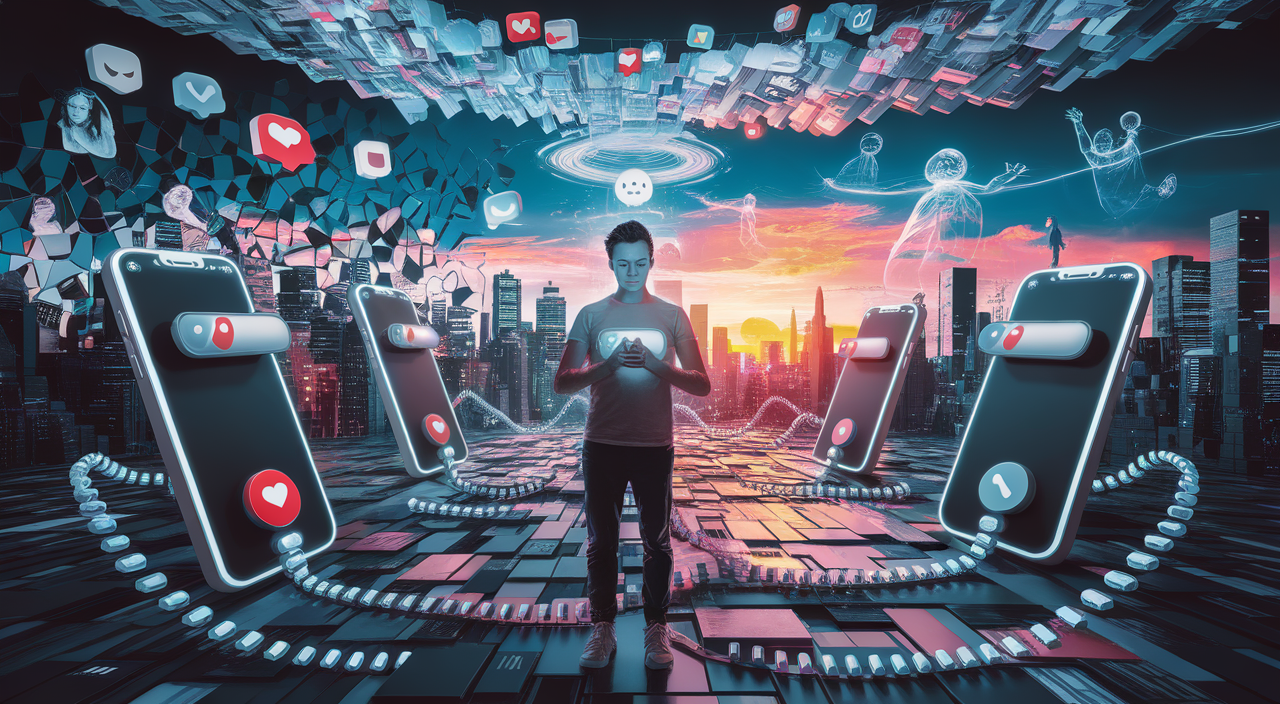The Social Media Overload Spiral has created a concerning digital dependency cycle, with 83% of Gen Z feeling anxious when separated from their phones and the average user spending 151 minutes daily on social platforms. This pattern mirrors addiction mechanisms, as excessive use triggers stress that ironically drives users to seek comfort in more scrolling, creating a self-perpetuating cycle of digital captivity.
Key Takeaways
- Social media platforms deliberately exploit psychological vulnerabilities through intermittent rewards, social comparison triggers, endless scrolling, and dopamine-driven feedback loops.
- The average person receives 65-80 smartphone notifications daily, fragmenting attention and making it increasingly difficult to focus on meaningful tasks.
- Excessive social media use negatively impacts brain function, including attention span, decision-making abilities, memory retention, and anxiety levels.
- Young adults (18-34) are particularly vulnerable, with 75% experiencing FOMO that fuels the overload spiral.
- Breaking free requires intentional strategies like setting time blocks, removing notifications, unfollowing negative accounts, creating phone-free zones, and using platform-specific control tools.
The Hidden Costs of Your Social Media Addiction: A Mental Health Crisis
Understanding the Social Media Overload Spiral
The shocking reality of our digital dependence has never been clearer – 83% of Gen Z experience anxiety when separated from their phones. I’ve seen how this attachment morphs into a Social Media Overload Spiral, creating a vicious cycle of stress and compulsive usage that mirrors patterns seen in virtual relationship addictions.
In 2023, users clock an average of 151 minutes daily on social media platforms. This isn’t just casual browsing – it’s reshaping how we consume information, with 1 in 5 Americans now getting their primary news from social media. The Social Media Overload Spiral kicks in when excessive use triggers stress, pushing users to seek comfort in even more scrolling, similar to how people develop emotional dependencies on AI companions.
The Psychology Behind Digital Captivity
Social media platforms leverage powerful psychological triggers to keep users engaged, creating what experts call a ‘cognitive hijack’. These platforms aren’t just social spaces – they’re carefully crafted systems that exploit our psychological vulnerabilities through:
- Intermittent reward systems that mirror gambling mechanics
- Social comparison triggers that fuel anxiety and FOMO
- Endless scroll features that blur time perception
- Dopamine-driven feedback loops through likes and notifications
This manipulation has created a new form of digital dependency that’s particularly concerning when combined with the Social Media Overload Spiral. The attention economy has turned our focus into a commodity, leading to what many experience as an emotional tether to digital platforms.
The platforms’ design intentionally taps into core human needs – recognition, connection, and validation. However, instead of fulfilling these needs, they often create a superficial sense of satisfaction that requires increasingly frequent engagement to maintain. This artificial fulfillment contributes to the spiral, as users chase digital connections while potentially neglecting real-world relationships and mental health.
Your Brain on Social Media: The Science Behind the Scroll
The Social Media Overload Spiral: Dopamine and Disruption
Social media platforms have mastered the art of hijacking our brain’s reward system. Just like slot machines, these apps use variable reward schedules that keep us checking our phones repeatedly. I’ve noticed this pattern mirrors classic addiction cycles — the anticipation of potential likes, comments, or messages triggers dopamine releases that create powerful feedback loops.
The bombardment is relentless. Studies show the average person receives 65-80 smartphone notifications daily, fragmenting our attention into tiny, scattered pieces. This constant interruption creates a Social Media Overload Spiral that makes it increasingly difficult to focus on meaningful tasks.
Physical and Cognitive Impact
The Social Media Overload Spiral affects us on multiple levels. The blue light from our screens wreaks havoc on our natural sleep patterns by suppressing melatonin production. I’ve seen how this disruption can lead to a vicious cycle — poor sleep quality leads to increased social media usage, which further damages sleep patterns.
This digital overload has transformed how our brains process information. Here’s what happens during excessive social media use:
- Attention span fragments due to constant context switching
- Emotional content triggers stress responses
- Decision-making abilities decrease from information overload
- Memory retention suffers from reduced deep focus
- Anxiety levels spike from constant comparison and FOMO
The endless scroll feature, combined with emotionally-charged algorithmic content, creates a perfect storm for addiction. I’ve observed how this digital dependency affects emotional well-being and can lead some users to seek comfort in artificial relationships through chatbots.
Many find themselves trapped in cycles of compulsive digital behavior, leading them to explore alternative forms of digital connection. The key lies in recognizing these patterns and implementing strategic breaks to reset our neurological responses.
Breaking Free: From FOMO to Digital Freedom
Understanding the Social Media Overload Spiral
The Social Media Overload Spiral hits young adults particularly hard, with 75% of those aged 18-34 caught in the grip of FOMO. I’ve seen how this constant fear of missing out fuels excessive platform use, creating a cycle that’s tough to break. According to Johns Hopkins, spending more than 3 hours daily on social media significantly increases anxiety and depression risks — a stark reminder of how the Social Media Overload Spiral affects mental health.
Practical Steps to Combat Social Media Overload Spiral
Just like those dealing with virtual relationship dependencies, breaking free from social media overload requires intentional action. Here are key strategies to regain control:
- Set specific time blocks for social media use
- Remove notifications from non-essential apps
- Unfollow accounts that trigger negative emotions
- Create designated phone-free zones in your home
- Use built-in platform tools like Instagram’s ‘Take a Break’
Similar to how some individuals develop unhealthy attachments to AI companions, social media can become an emotional crutch. I recommend using apps like Freedom or Forest to track and limit your screen time. These tools act as digital boundaries, much like the safeguards needed when dealing with AI relationship dependencies.
The key is replacing mindless scrolling with purposeful engagement. Instead of passive consumption, I suggest scheduling specific times for checking social media, treating it like any other daily task. This approach helps prevent the kind of emotional dependence that mirrors excessive reliance on AI for emotional support.
Through consistent application of these strategies, you can transform your relationship with social media from compulsive to controlled. By implementing platform-specific tools like TikTok’s screen time prompts and creating tech-free spaces, you’ll start breaking the Social Media Overload Spiral one step at a time.
Constant notifications and endless scrolling can quickly lead to burnout, trapping users in a cycle of digital fatigue without them even realizing it.
Sources:
DataReportal – Digital 2024 Global Overview Report
Statista – Daily Social Media Usage Worldwide
Pew Research Center – Social Media Use in 2021
Johns Hopkins Bloomberg School of Public Health – Social Media Use by Adolescents Linked to Internalizing Behaviors
ScienceDirect – Computers in Human Behavior
Center for Humane Technology
Deloitte – Digital Consumer Trends Data







